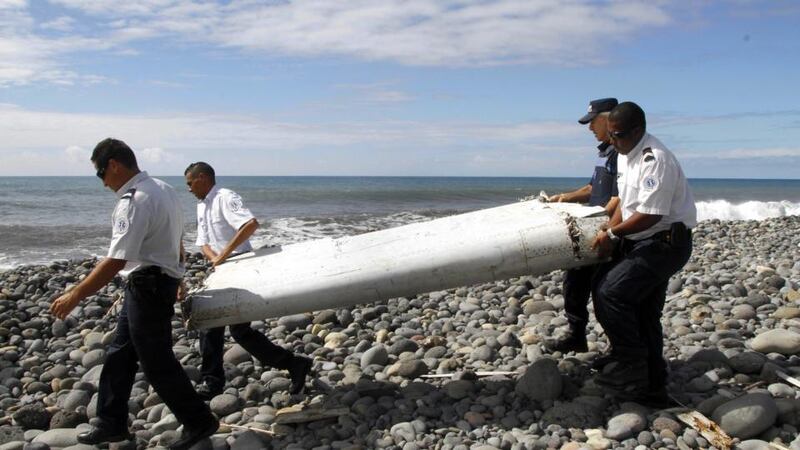Malaysian prime minister Najib Razak has confirmed that a Boeing 777 wing segment discovered in the Indian Ocean island of Reunion is from the missing Flight MH370 - the first real breakthrough in the search for the plane that disappeared 17 months ago.
"The international team of experts have conclusively confirmed that the aircraft debris found on Reunion Island is indeed from MH370," Mr Najib said in a televised statement.
Malaysia Airlines Flight MH370 disappeared in March last year en route from Kuala Lumpur to Beijing with 239 passengers and crew on board.

Tying the debris to the doomed Boeing 777 validates authorities’ hypothesis that the plane crashed in a remote stretch of the Indian Ocean, southwest of Australia. But the discovery of the piece thousands of kilometres away on France’s Reunion island doesn’t pinpoint where the aircraft took its fatal plunge in March 2014 - and why it strayed so far from its intended route.
‘Major breakthrough’
“This is indeed a major breakthrough for us in resolving the disappearance of MH370,” Malaysia Airlines said in a statement.
“We expect and hope that there would be more objects to be found which would be able to help resolve this mystery.”
Malaysia Airlines said its priority would be to update families and co-operate with authorities “on the investigation and recovery of this tragic accident”, it added.
The part found on Reunion is a flaperon, a movable panel on the rear of the wing that can be moved to expand the wing’s size during takeoff and landing. It was sent from Reunion, a French territory, to a government laboratory in Toulouse for examination, along with a suitcase found nearby.
In the absence of any wreckage, other theories had proliferated: perhaps the jet had landed in central Asia, or perhaps it didn’t really double back across the Malaysian peninsula as radar tracks indicated. The discovery in the Indian Ocean settles that question.
“Today, 515 days since the plane disappeared, it is with a heavy heart that I must tell you that an international team of experts have conclusively confirmed that the aircraft debris found on Reunion island is indeed from MH370,” Mr Najib said at the briefing.
‘Not the end’
“It’s not the end,” said Jacquita Gonzales, who lost her husband Patrick Gomes, a flight attendant on board the aircraft.
“Although they found something, you know, it’s not the end. They still need to find the whole plane and our spouses as well. We still want them back,” she said.
Despite the Malaysian confirmation it was part of MH370, prosecutors in France, where the flaperon is being scrutinised, stopped short of declaring they were certain, though they said there was a very strong likelihood it was the case. A piece of luggage also found in Reunion would be examined by French police, they said.
The lab conducting the examination is the same one that assessed debris from an Air France jet that plunged into the Atlantic Ocean in 2009.
The examination is being carried out under the direction of a judge at an aeronautical test facility run by the French military at Balma, a suburb of the southwestern city of Toulouse, and witnessed by Malaysian officials.
Investigators looking at the wing flap are likely to start by putting thin slices of metal under a high-powered microscope, to see subtle clues in the metal’s crystal structure about how it deformed on impact, said Hans Weber, president of TECOP International, Inc, an aerospace technology consulting firm based in San Diego, California.
Examine organisms
They can examine organisms on the wing for evidence about the part’s path in the ocean, he said.
Later, investigators would probably clean the piece and “do a full physical examination, using ultrasonic analysis before they open it up to see if there’s any internal damage, Mr Weber said. “That might take quite awhile. A month or months.”
John Goglia, a former member of the US National Transportation Safety Board, told Reuters: “The real work is yet to begin.”
“They will identify everything they can from the metal: damage, barnacles, witness marks on the metal. They‘re going to look at the brackets (that held the flaperon in place) to see how they broke.
From that they can tell the direction and attitude of the airplane when it hit. There’s a lot to be told from the metal.”
Officials from the US and manufacturer Boeing were also on hand in France to advise whether the piece could be tied to Flight MH370, which went missing on March 8th last year while en route from Kuala Lumpur to Beijing. Boeing declined to comment.
Metal analysis
The Balma test centre specialises in metal analysis and is equipped with a scanning electron microscope capable of 100,000 times magnification.
The Boeing 777 was minutes into its scheduled flight when it disappeared from civil radars. Investigators believe that someone deliberately switched off the aircraft’s transponder, diverted it thousands of miles off course, and deliberately crashed into the ocean off Australia.
In January, Malaysia Airlines officially declared the disappearance an accident, clearing the way for the carrier to pay compensation to relatives while the search goes on.
A $90 million hunt along a rugged 60,000 sq km patch of sea floor 1,600 km (1,000 miles) west of the Australian city of Perth has yielded nothing.
The search has been extended to another 60,000 sq km (23,000 sq miles) and Malaysian and Australian authorities say this will cover 95 per cent of MH370’s flight path.
Reuters/Bloomberg










